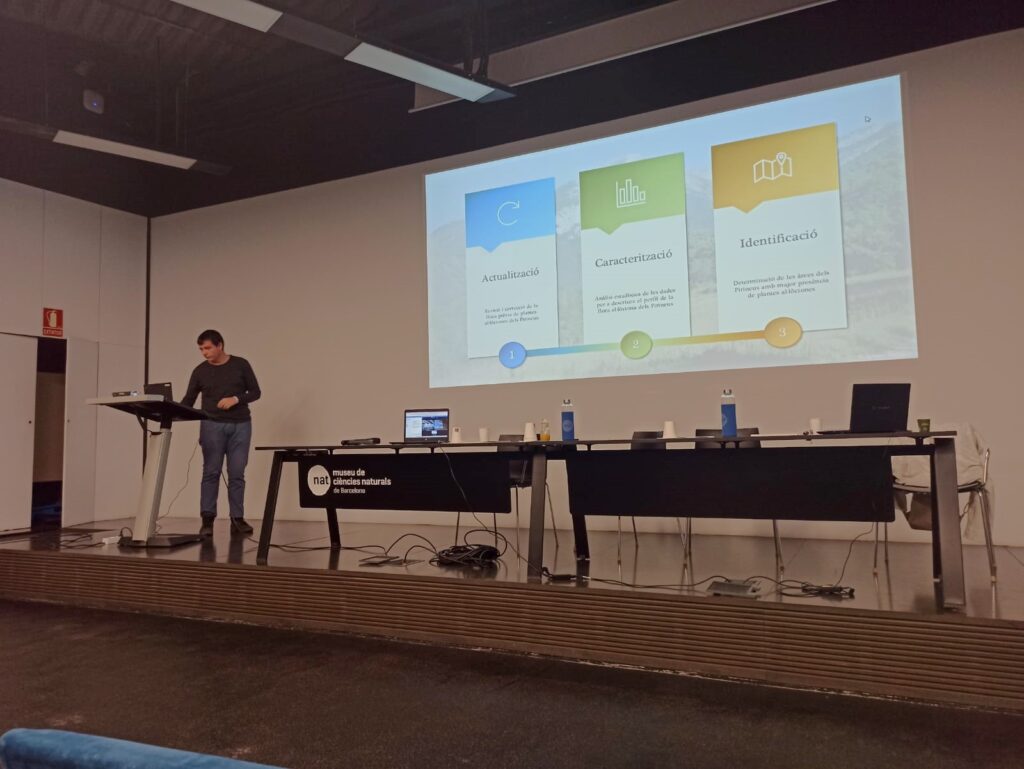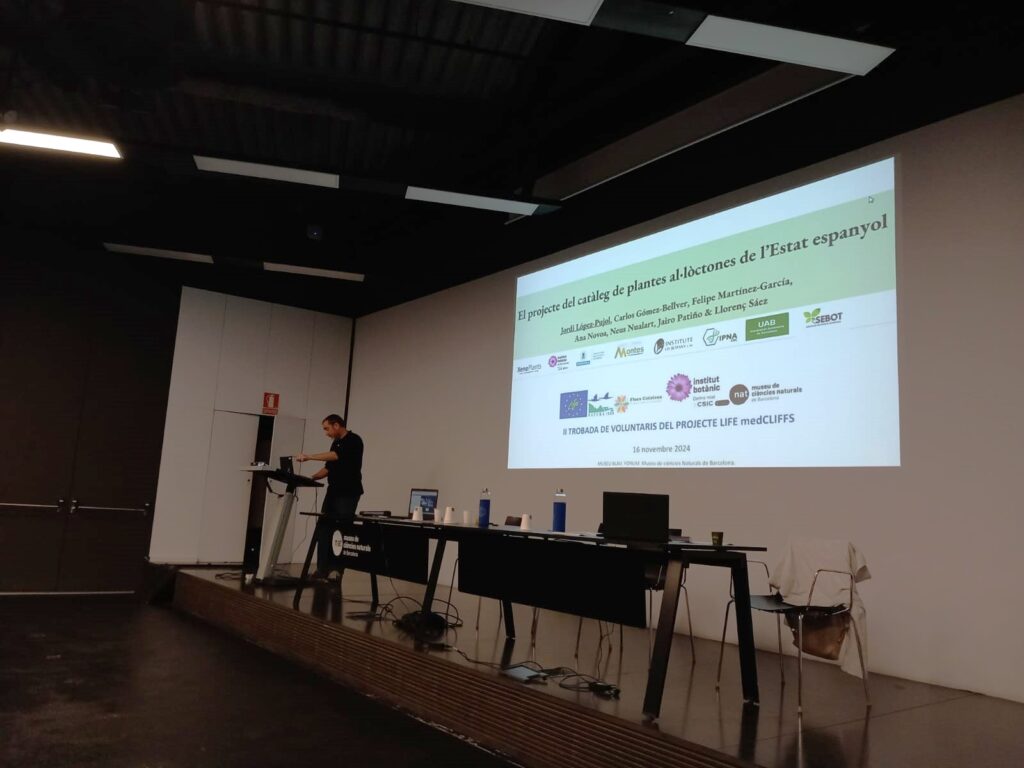
This year, on November 16, 2024, the second annual meeting of volunteers of the LIFE medCLIFFS project was held at the Barcelona Museum of Natural Sciences, in the Forum. Organized by the Botanical Institute of Barcelona, the Barcelona Museum of Natural Sciences and the Flora Catalana association, they welcomed 20 people from different parts of Catalonia and held several communications, both at a scientific and didactic level, presenting the project’s progress.
The project’s evolution
Flora Catalana emphasized the hours issue by communicating that volunteers must record the hours of transect surveying, especially for couples who must record both the round trip and the surveying of both people. They argued that there is one year left in the project to finish spending the budgeted hours, and in two years, half have been recorded (54.72% of total hours done), so we need to use the rest by the end of next year.

Francesc Caralt (Flora Catalana) shows the different hours budgetted in the project.
They also showed the comparison of data for 2023-2024. It was commented that almost all the species, of the 33, to be observed in the volunteer network have already been found. In addition, practically all the transects are adopted, 100 of 106 (94%) compared to 84 in 2023 (79%). We currently have 105 volunteers, although 47 have not yet recorded their hours, so it was reminded that this is a fundamental part of this part of the project, since it is the monitoring justification in the reports.

Neus Ibáñez (IBB-MCNB) presents the novelties and changes from 2023 and 2024.
Lichens
Maria José Chesa complemented the session by giving a small seminar on the world of lichens; explaining their physiology, diversity and some examples of various species she had found on the Costa Brava. At the same time, she encouraged people to collaborate on the iNaturalist project “Líquens del Parc Natural de Cap de Creus”. This way, volunteers from the natural park area can contribute biodiversity data on both plants for the LIFE medCLIFFS project and lichens to the Lichens of the Cap de Creus Natural Park project.

Maria José Chesa (Applied Lichenology) talks about the diversity and physiology of lichens.
Allochthonous Flora of the Pyrenees
He presented the study of a complete and updated catalogue of non-native plants from the Pyrenees (northeast of the Iberian Peninsula) since we remember that this ends at Cap de Creus where the mountains meet the sea. The total number of non-native taxa in the Pyrenees is 615, belonging to 99 families and the most diverse genera are Amaranthus (13 taxa), Solanum (10 taxa), Erigeron (9 taxa) and Prunus (9 taxa). Approximately two-thirds of the plants are native to America, the Mediterranean basin and the western Palearctic area, while the remaining 32% come from other regions. He also commented that the most important form of introduction is gardening (57.2%), followed by agriculture and commerce, while forestry is marginal. Most non-native taxa are therophytes, that is, annual and perennial herbs, while other forms of vegetation are less represented. One point to highlight was that the non-native flora is not uniformly distributed in the Pyrenees; the geographical areas with the most taxa are the most eastern and, also, the most anthropized. This study, in summary, shows that the Pyrenees are a hotspot of non-native flora and that, control mechanisms must be implemented to prevent expansion throughout the territory and the consequences that this would have on native species and ecosystems.

Javier Martínez (IBB) presents the Allochthonous Flora of the Pyrenees.
Catalogue of allochthonous plants of the Spanish Estate
The only catalogue of alien plants in Spain is from 2004. But now, a group of researchers from all over Spain will produce an updated version. In terms of biological invasions and ling in a globalized world like today, 20 years is a very long period in which many changes can occur. It is not finished yet, but it already has more than twice as many taxa as those in the 2004 catalogue (around 2000 compared to 900 in 2004).

Jordi López (IBB-CSIC) presents the project “Catalogue of allochthonous plants of the Spanish Estate”.
The Code of Conduct
A new feature of the project was presented: the Code of Conduct, which is also linked to the lists of plants (consensus, surveillance and white) reviewed by the project’s expert committee some of which include plants already banned in Spain. This code of good practices is designed mainly for producers and sellers of live plants and the design of an alternative list of plants (white) to promote gardening with native flora or with plants of low invasiveness. It is mainly a tool intended for the life plant trading sector. Broadly, those who adhere to this code commit to meticulously buying, and selling, plants that do not have a risk of invasion, or that it is very low. To promote this conduct to related entities, alert those that are not complying and at the same time be respectful of the environment. Therefore, if each person indirectly promotes the dispersion of non-native plants through their purchases it is vital that, as final recipients, they know the situation and are more aware of their actions. Another issue that went along with the code is the quality seal. An identification, which is still being developed, to be able to give and certify to related sectors and that can be recognized as an institution adhering to the code. In this way, buyers can also recognize, or find out about, these values in the entities that have acquired them.

Arnau Bosch (IBB-CSIC) presents the Code of Conduct to the volunteers and the new initiative “Plant another one!”, promoting non-invasive alternative plants.
Round table
Once the presentations were over, a round table discussion took place and volunteers were invited to comment, discuss and give their opinions on everything related to the project.
One of the positive comments was directed at the new proposal for the code of conduct, the quality seal. The attendants believed that giving a distinction of sustainability recognition was very positive for both parties. It was also considered an extra value and given more points when buying or contracting companies. They highlighted the focus on the positive side, rewarding those who make this commitment, and not penalizing those who have not acquired it.
On the contrary, a general concern was the prospect of eradicating invasive plants as an impossible task. A much-debated topic that should be reviewed step by step, especially after the results are obtained for both the risk of plant invasion and the treatments and management of each taxon.
Linked to the previous matter, people wondered how the impact of invasive species could be measured. They were presented with the EICAT tool (Environmental Impact Classification for Alien Taxa), a new tool, designed by the IUCN (International Union for Conservation of Nature), to study cases of invasion by a taxon in a similar way to how they do it for the state of conservation.
At the end of the round table, volunteers were invited to visit the museum freely until 3 pm, which ended the day.

Group photo of the LIFE medCLIFFS team and the volunteers.



